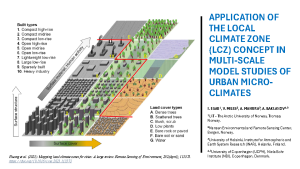Project Description

The presentation on “Application of the local climate zone (LCZ) concept in multi-scale model studies of urban micro-climates” was delivered during the Atmosphere and Climate Competence Centre (ACCC) & Finnish Atmospheric Science Network (FASN) Science Conference held at the premises of the University of Helsinki and the Finnish Meteorological Institute during 10-12 November 2025 (Helsinki, Finland).
The study is based on analysis of the existing LCZ from the World Urban Database and Access Portal Tools (WUDAPT) for high-latitude cities and towns. The WUDAPT Level-0 method applies supervised classification of satellite imagery to delineate LCZ classes, offering consistency across regions and facilitating inter-city comparisons.This classification has been corrected to reflect the climate zones more accurately in our target cities using the high-resolution land surface temperature data from imagery of the Thermal Infrared Sensor (TIRS) on Landsat 8. TIRS provides thermal data at a native 100- meter resolution, which is resampled MODIS and LandSat datasets. The LCZs were then aggregated and upscaled to provide input of LoDs into meso-scale Enviro-HIRLAM and micro-scale PALM simulations. The models in use are taken from the PEEX modelling platform. The simulations have been completed for different weather conditions over the whole Scandinavia, whereas the analysis is currently completed only for a small selection of cities, primarily for Bergen and Tromsø, Norway.
Our analysis reveals a significant disproportionate impact of large buildings on characteristics of urban micro-climate. Both thermal (UHI) and dynamical properties of the urban atmosphere are affected. Satellite data analysis shows that the LCZ-8 areas are the warmest areas in the studied high-latitude cities, although the anthropogenic heat flux is not necessarily peaks there. The aggregated effect for the meso-scale Enviro-HIRLAM model would be such that the model will predominantly respond to properties of the LCZ8 areas. Furthermore, we simulated the urban atmospheric dynamics in the selected cities. The PALM model output revealed that not only temperature but also the dynamical properties of micro-climates are specific and could be characterized by LCZs. Large buildings in LCZ-8 (Kronstad – the area was built-up with large buildings after the fire in 1917) has significantly slower winds than areas with densely packed small buildings (Bergen Hus).
The preliminary results of this study support the idea that LCZs could be used not only for thermal climate characterization but also more holistically for description of urban atmospheric dynamics and vertical mixing, and therefore urban air pollution dispersion.
See more details in the presentation.
Text by: Igor Esau, UiT – The Arctic University of Norway, Tromsø, Norway
